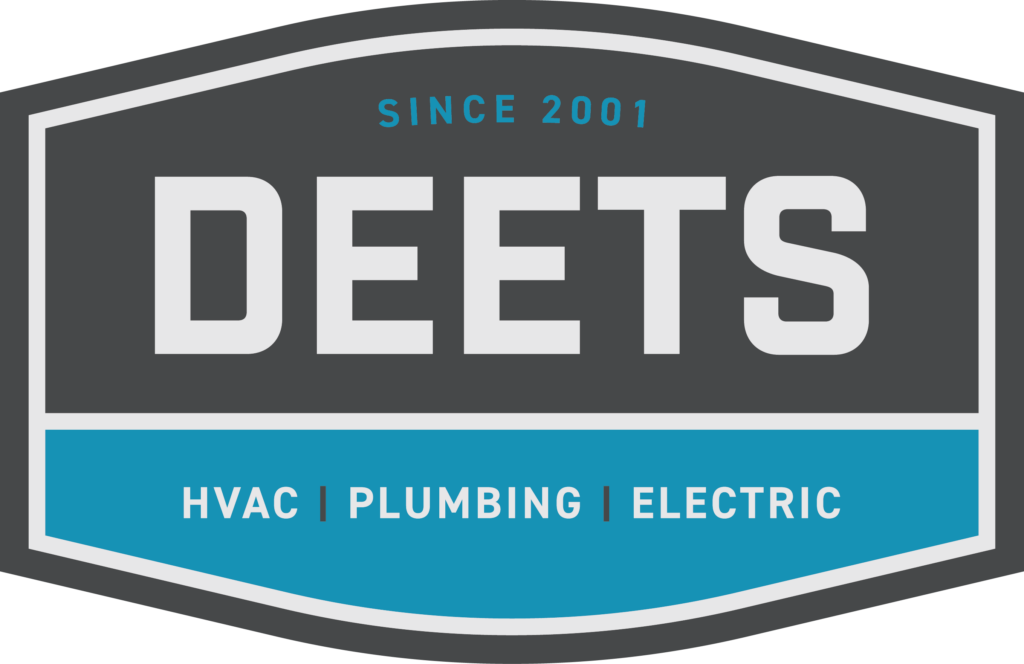In this article…
- 8 Plumbing Elements To Winterize Around Your Home
- Why Winterizing Your Plumbing Is Important
- Preparing Your Plumbing For Winter And Avoiding Potential Problems
As the seasons transition from summer to fall and into the brisk winter, ensuring your home is ready to handle the storm is crucial. This includes winterizing your plumbing to withstand freezing temperatures and keeping the water flowing until springtime comes.
Imagine cozying up with a warm cup of hot cocoa by the fireplace when suddenly…POP!
The last thing you want is a water pipe bursting when temperatures are below zero.
Not only can it be difficult for emergency plumbing services to get to your home when you need them most, but what’s worse is that most winter plumbing issues are completely preventable with the right preparation.
DEETS has been the plumbing, HVAC, and electrical experts in the Northwestern Pennsylvania area since 2001, providing homeowners with high-quality services through the good, the bad, and the ugly.
Along with our premium work performed by licensed, experienced technicians, we want to educate you with all the information you need to protect your plumbing all year round.
Whether you’ve worked with us before or simply want expert advice on keeping your plumbing and your home safe through the winter, we’re here to help by educating you on the top plumbing winterization tips.
This article will outline 8 things in a checklist to prepare your plumbing for the winter before it’s too late, from insulating your outdoor spigots to letting faucets drip and more.
After reading, whether you’re a seasoned winter veteran or a new homeowner in the north, you’ll have a comprehensive outline of what to check and how to prepare your plumbing for the winter to avoid potential problems until spring.
8 Plumbing Elements To Winterize Around Your Home
Inspecting and protecting plumbing elements in and around your home before the first winter freeze comes is crucial to avoid pipe bursts, frozen pipes, and leaks.
Reviewing this checklist will ensure you inspect all plumbing in your home, ensure they are properly winterized, and avoid potential problems and emergencies.
Let’s look at eight things to winterize around your home and some of the best ways to protect them from the cold.
1. Swimming Pools
Once it’s gotten too cold to utilize your swimming pool, prepping it for winter early on will allow you to get this chore out of the way before moving on to winterizing other exterior plumbing elements around your home.
Here are four tips to winterize your pool.
- Lower the Pool’s Water Level: Drop the water below the plumbing lines but follow the manufacturer’s or pool specialist’s recommendations.
- Balance Water Chemistry: Adjust your pool’s pH, alkalinity, and sanitizer levels to protect against corrosion and scale buildup.
- Add Pool Antifreeze: For above-ground pools, add non-toxic antifreeze to the plumbing.
- Cover the Pool: Secure a winter cover to protect it from debris and provide better insulation for the pool.
If you forget or neglect to winterize your swimming pool, you risk freezing pipes, pipe bursts, and damage to the pool liners and pool walls.
2. Spas and Jacuzzis
When the temperature drops, there’s nothing like taking a nice soak in your hot tub. But, the last thing you want is to find something broken when all you want is to relax and unwind.
Prep your spas, jacuzzis, and hot tubs with these tips.
- Clean Filters: Remove, clean, and dry the filters before storing them for the winter.
- Loosen Fittings: Slightly loosen any PVC pipe fittings to allow for expansion should any water remain and freeze.
- Cover Securely: Use a quality insulated cover to keep out debris and help maintain structural integrity.
- Drain Completely: Drain all water from the hot tub or jacuzzi if you won’t be using it for an extended amount of time. This includes the heater and blowers to prevent any remaining water from freezing and causing damage.
Similar to your swimming pool, not winterizing your jacuzzis and hot tubs can result in water freezing and damaging components.
Winter damage can also cause system failure on electrical components, making you spend more on costly repairs once springtime comes.
3. Water Pumps
Your water pump is essential to provide your home with efficient plumbing. Whether you have a well or utilize water from the city supply, you never want your water pump to stop working (especially when you need a hot shower to escape the cold).
To keep your water flowing all winter long, follow these steps to protect your water pump.
- Insulate Pump and Pipes: If the pump must remain outdoors, insulate it with foam covers or heating tape.
- Maintain the Temperature of the Pump House: If your water pump is stored in a pump house detached from the home, ensure the pump house is at an optimal temperature to help prevent freezing.
- Inspect Water Pump Prior to Freezing: Before it gets too cold, have a professional plumbing company inspect your water pump for potential leaks, mechanical issues, and efficiency.
Failing to insulate your water pump can result in freezing pipes and components, mechanical issues, and total failure, leaving you with no water in your home and needing emergency plumbing services.
4. Sump Pumps
A sump pump is typically located in the basement of your home as well as crawl spaces. They are responsible for collecting water overflow, whether from groundwater through the soil or after heavy rains, and pumping the water out and away from the home.
Your sump pump is essential in the wintertime, especially when heavy snow melts and can potentially intrude into your basement.
Winterize your sump pump with these tips.
- Inspect and Clean: Ensure the sump pump is clean and debris-free; check the discharge line for obstructions.
- Insulate Discharge Line: Protect the discharge line from freezing, which could block the flow of water being pumped out.
If the discharge line freezes, it can cause the sump pump to overwork and eventually burn out or fail, leading to potential flooding.
A non-functioning sump pump can then lead to water backing up, causing flooding and water damage in your basement or crawl space.
5. Fountains, Water Features, and Ponds
Any outdoor water feature around your home contains plumbing that must be protected during the winter for it to continue flowing and providing aesthetic appeal in the spring and summer.
To keep your fountains, water features, and ponds protected, follow these winterization tips.
- Drain and Clean: It’s best to completely empty the fountain and clean all elements, including pumps, pipes, and the basin.
- Cover: Cover the fountain to protect the structure from freezing temperatures and debris.
- Remove and Store Pumps: If feasible, remove the pump and store it in a frost-free location.
- Remove and Store Any Wildlife: If you have a pond with live fish or turtles, remember to remove them and keep them in a tank indoors until the temperature is warm enough, both outside and in the water, for them to safely return.
Protecting your fountains and any water feature outdoors will ensure they last through winter and will save you on any repairs afterward.
6. Livestock Water Systems
Making sure your livestock tanks are fully stocked and don’t freeze up during the winter is crucial to protecting and caring for your animals.
Whether you have freestanding water tanks or a plumbing system to pump water directly into tanks and barns, follow these winterization tips to prevent any water distribution issues.
- Install Tank Heaters: Use submersible heaters to keep water from freezing in freestanding water tanks.
- Check and Install Insulation: Inspect and repair any damaged insulation around exposed pipes and hoses. Install added insulation around any damaged insulation or in spots that have caused issues before.
- Regular Maintenance: Ensure float valves and all other components of water tanks, pumps, and valves are functioning correctly to prevent freezing.
If freezing temperatures impact your livestock’s water supply, this can lead to dehydration of animals and other health issues. Not insulating or properly heating water supplies can also lead to plumbing damage and costly repairs.
7. Exterior Drain Lines
Ensuring your drain lines are clear and able to properly drain water from your home and keep water flowing through your plumbing properly.
Once freezing temperatures start to arrive, be sure to follow these tips to protect your exterior drain lines.
- Clear Debris: Ensure all exterior drains are free from leaves and other debris to prevent clogging and ice buildup.
- Insulate Exposed Piping: Use insulated covers or foam pipe sleeves for any exposed piping associated with the drains.
If water freezes in your drain lines, it can expand and damage the pipes, causing a leak. Ice blocking the drain lines also inhibits water from properly draining, leading to water damage or potential flooding.
8. HVAC Unit
Although your HVAC system is separate from your plumbing system, it still contains elements that can freeze up and cause irreversible damage, leaving you with no heating this winter.
Protect your HVAC unit with these winterization tips.
- Inspect and Clean Air Ducts: Have your air ducts inspected for leaks, blockages, or damage. Clean ducts improve efficiency and indoor air quality.
- Clear the Area Around the Outdoor Unit: Remove any debris, leaves, or branches that have gathered around the outdoor unit. This debris can obstruct airflow and reduce the system’s efficiency.
- Inspect the Insulation: Check the insulation on refrigerant lines running into the house. Replace any insulation that has deteriorated to maintain proper heating efficiency.
- Cover the Outdoor Unit: Consider covering the outdoor unit to protect it from winter debris and ice. However, ensure that the cover is breathable to prevent condensation and the resulting corrosion.
Protecting your outdoor condenser from freezing temperatures as well as insulating drain and refrigerant lines will help maintain your HVAC system and keep you warm all winter long.
Why Winterizing Your Plumbing Is Important
Ensuring any plumbing element in your home is properly prepared before freezing temperatures blow through is an essential maintenance step for any homeowner in areas where temperatures regularly drop below freezing.
The biggest risk of not winterizing your plumbing is water freezing within the pipes. When water inside pipes freezes, it expands with significant force. This expansion can cause pipes, regardless of whether they are made of plastic or metal, to crack or burst.
The damage can lead to extensive water leakage, which not only wastes water but can also cause severe water damage to a home’s structure as well as the interior and exterior of your home.
Severe water damage left untreated can also breed microbial growth throughout your home, posing long-term health risks on top of damage to your home.
The repair costs for burst pipes and the subsequent water damage can be substantial, not to mention the inconvenience and potential temporary displacement from one’s home while repairs are carried out.
Properly winterizing your plumbing not only protects the physical aspects of your home but also maintains the efficiency and longevity of your plumbing systems.
Reduced incidences of leaks and damages mean less water wasted and more money saved on utility bills and potential repairs. It also means peace of mind during the cold months, knowing that your home is well protected from preventable mishaps.
Winterizing all plumbing systems in your home safeguards against the potentially severe consequences of freezing temperatures on home plumbing systems.
Preparing Your Plumbing For Winter And Avoiding Potential Problems
Now that you have a full checklist of eight plumbing elements to winterize around your home, tips on how to prep them for winter, and the importance of winterizing your plumbing, you are ready to prep your plumbing for winter before it’s too late.
The truth is, though, it’s never too late to winterize your plumbing even if temperatures are below zero. As long as there is no preexisting damage to your plumbing, taking the necessary steps to protect your plumbing before any problems occur is essential.
Your swimming pools, hot tubs and spas, water pumps, sump pumps, fountains, water features, livestock water systems, exterior drain lines, and HVAC system are some of the crucial plumbing elements around your home that should be winterized.
Ensuring any plumbing component around your home is correctly insulated, stored away, or has the necessary heating system to keep the plumbing protected and water flowing will help avoid potential freezing and pipe bursts, or even worse, no water to your home.
At DEETS, we know how harsh Northwestern Pennsylvania winters can be. Once temperatures drop below freezing, assuring your entire home is winterized and ready to take on the snow is important.
We’re here to provide you with all the necessary information to properly winterize your home and keep you safe all winter long, but we understand it can be overwhelming at times, especially for new homeowners.

Schedule your appointment with a DEETS expert today to get your plumbing inspected before the first freeze and get custom insight on how to winterize your plumbing this year!



